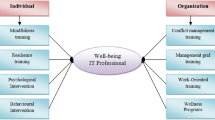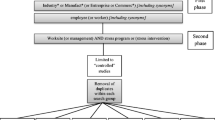Abstract
Job stress is an important area for study among Industrial/ Organizational Psychologists. Previous studies have noted the relationship of stress to psychological, physiological and behavioral functions among employees. Little research has been done to intervene and reduce the effects of stress on workers, and to document the impact of reduced stress on corporate level outcomes. The present case evaluates a comprehensive hospital stress intervention program designed to reduce losses that have been associated with stress, such as accidents and associated medical costs. An organizational stress survey, theHuman Factors Inventory (HFI), was administered and the results compiled, followed by the implementation of organization-wide stress intervention programs. The purpose here is to assess changes from pre-intervention to post-intervention in insurance losses due to accidents.
Similar content being viewed by others
References
Beehr, T. A. (1976). Perceived situational moderators of the relationship between subjective role ambiguity and role strain.Journal of Applied Psychology, 61, 35–40.
Beehr, T. A. and Newman, J. E. (1978). Job stress, employee health and organizational effectiveness: A facet analysis, model and literature review.Personnel Psychology, 31, 665–699.
Beehr, T. A., Walsh, J. T., and Taber, T. D. (1976). Relationships of stress to individually and organizationally valued states: Higher order needs as a moderator.Journal of Applied Psychology, 61, 35–40.
Caplan, R. D., Cobb, S., French, J. R. P., Jr., Van Harrison R., and Pinneau, S. R. (1975).Job demands and worker health: Main effects and occupational differences. Washington, D.C.: U.S. Government Printing Office.
Cobb, S. and Kasl, S. V. (1972). Some medical aspects of unemployment. In G.M. Shatto (Ed.):Employment of the middle-aged: Papers from industrial gerontology seminars. Illinois: Thomas, (1975). 87–96. Reprinted inIndustrial Gerontology, 12.
Coburn, D. (1975). Job-worker incongruence: Consequences for health.Journal of Health and Social Behavior, 16, 198–212.
Cooper, C. L. and Payne, R. (1978).Stress at work. New York: John Wiley and Sons.
Gemmil, G. R. and Heisler, W. J. (1972). Machiavellianism as a factor in managerial job strain, job satisfaction, and upward mobility.Academy of Management Journal, 15, 51–62.
Hennigan, J. K. and Wortham, A. W. (1975). Analysis of workday stresses on industrial managers using heart rate as a criterion.Ergonomics, 18, 675–681.
Jones, J. W. (1986).The burnout syndrome: Current research, theory and interventions. Park Ridge, Illinois: London House Press.
Jones, J. W. (1983).The Human Factors Inventory (HFI). Saint Paul, MN: The Saint Paul Companies.
Jones, J. W. and Dosedel, J. (1986). Impact of corporate stress management on insurance losses.Legal Insight, 24–27.
Jones, J. W. and DuBois, D. (1985).The human factors surveys: Background and interpretation guide. Saint Paul, MN: Risk Management Department, The Saint Paul Companies.
Jones, J. W. and DuBois, D. (1986). A review of organizational stress assessment instruments. In Lawrence Murphy (Editor),Stress management: Conceptual and practical guidelines for worksite programs. Cincinnati, Ohio: National Institute of Occupational Safety and Health.
Kohn, J. P. (1981). Stress modification using progressive muscle relaxation.Professional Safety, 26, 15–19.
Murphy, L. R., DuBois, D., and Hurrell, J. J. (1986). Accident reduction through stress management,Journal of Business and Psychology, 5–18.
National Safety Council (1984).Accident Facts. Chicago: National Safety Council Press.
Nichols, K. A., Springford, V., and Searle, J. (1981). An investigation of distress and discontent in various types of nursing.Journal of Advanced Nursing, 6, 311–318.
Norusis, Marija J. (1986).SSPSS/PC + for the IBM PC/XT/AT. Chicago, Illinois: SPSS Inc., Section C, 105–106.
Reeder, L. G., Schrama, P. G., and Dirken, J. M. (1973). Stress and cardiovascular health: An international cooperative study: I.Social Science and Medicine, 7, 573–584.
Schar, M., Reeder, L. G., and Dirken, J. M. (1973). Stress and cardiovascular health: An international cooperative study: II. The maLe population of a factory at Zurich.Social Science and Medicine, 7, 575–584.
Selye, H. (1974).Stress without distress. New York: The New American Library, Inc.
Steffy, B. D., Jones, J. W., Murphy, L. R., and Kunz, L. K. (1986). A demonstration of the impact of stress abatement programs on reducing employees' accidents and their costs,American Journal of Health Promotion, Fall, 1986,in press.
Tasto, D. L., Colligan, M. J., Skjei, E. W., and Polly, S. J. (1978).Health Consequences of Shiftwork. DHHS (NIOSH) Publication No. 78-154.
Vredenburgh, D. J. and Trinkaus, R. J. (1983). An analysis of role stress among hospital nurses.Journal of Vocational Behavior, 23, 87–95.
Author information
Authors and Affiliations
Rights and permissions
About this article
Cite this article
Kunz, L. Stress intervention programs for reducing medical costs and accident claims in a hospital. J Bus Psychol 1, 257–263 (1987). https://doi.org/10.1007/BF01020814
Issue Date:
DOI: https://doi.org/10.1007/BF01020814




